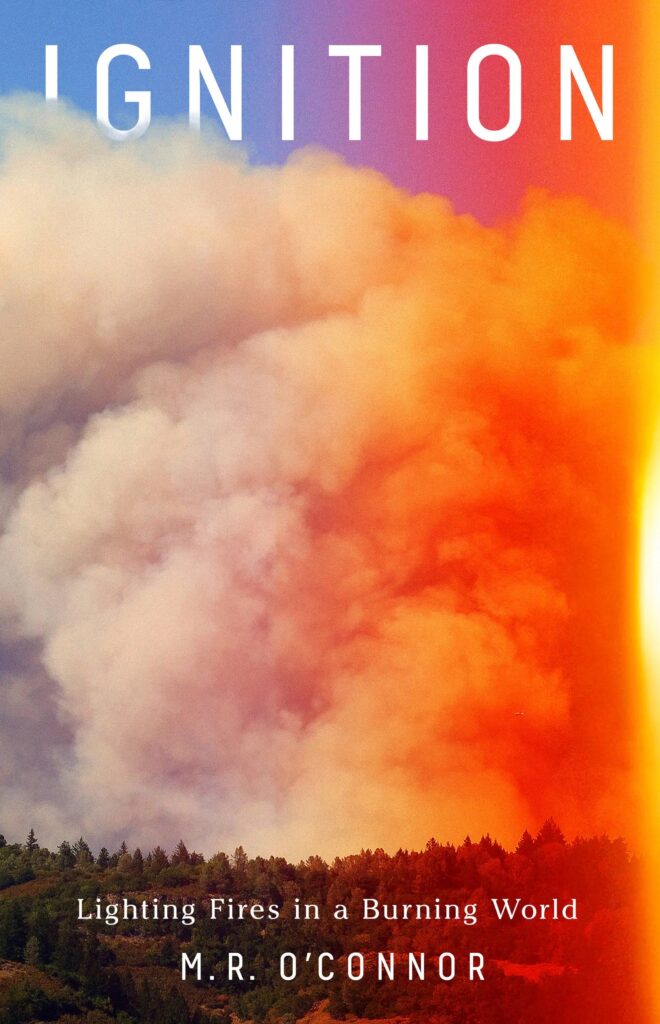
By M.R. O’Connor
Bold Type Books, 2023
384 pages, hardcover, $30
At its core, “Ignition: Lighting Fires in a Burning World” is a book about right relationship with land. In an age of megafires that burn so big and hot that they are prone to creating their own weather systems, M.R. O’Connor explores the use of prescribed fire. Sparked by her exposure to a burn-blackened forest on a trip to Australia, “Ignition” follows her curiosity across time and space, taking readers along for an illuminating ride.
O’Connor begins training as a wildland firefighter via online modules from her home in Brooklyn — for the Work Capacity Test, she fills her backpack with 45 pounds of sand and speed-walks 3 miles around a park. Once qualified, she embeds as a journalist on intentional burns as well as fire suppression crews across the country. In recounting her experiences, she traces the history of fire, delving into the record of anthropogenic burning and engaging with fire scholars. O’Connor frames the benefits and challenges to reintroducing pre-Colonial fire regimes via dozens of conversations with firefighter ground crews, hotshots, burn bosses, biologists and botanists, as well as cultural fire stewards — including descendants of fire practitioners in the South and members of several Indigenous tribes.
What unfolds is the intertwined existence between humans and fire — and an unshakeable foreshadowing of the damage yet to come due to the suppression of this relationship. Humans across the globe have been fire lighters for hundreds of generations, managing fire to regenerate landscapes. There are myriad examples of species that have evolved not only to withstand fire but to thrive in relationship to this “keystone natural process.” In the pine bush of what is now New York, there are “fire-ephemerals” whose seeds lie dormant until a fire burns the area, germinating upon a molecular interaction with “smoke water.” In this same biome, the endangered Karner blue butterfly relies on fire’s disturbance for the proliferation of wild blue lupine, its only food source.
As the concepts of French and German “scientific forestry,” which focused on timber yields and profit, swept the globe in the 19th century — in tandem with racist ideology — Indigenous cultural practices of burning were vilified and, in many places, outlawed as arson. The emergent narrative of “wilderness” gave rise to an environmental ethos of pristine, untouched land — in which land is preserved in an almost mythical state devoid of human interaction, as if humans were not animals existing within an ecosystem. This tension persists today in terms of reintroducing fire to areas that sorely need it, such as Yosemite National Park. The prescribed fire movement, which gained momentum in the 1960s, argues that decades of fire suppression on landscapes that were historically managed by fire has led to dense forests that are essentially tinderboxes — lightning strikes and errant electrical sparks, from powerlines or even cars, can and have ignited wildfires that have swept through millions of acres, turning towns to ash; risking the lives of residents and firefighting crews (many of whom suffer with PTSD); costing billions of dollars annually for suppression and rebuilding; and endangering — to the brink of extinction — individual species and whole ecological communities that have evolved with more moderate fires.
O’Connor is unabashedly pro-fire, continuing to earn more wildland firefighter qualifications — from reading the weather at a burn site to learning how to use a chainsaw to hold a fireline. Her firsthand experiences and passion for understanding how fire can move through any given landscape, with and without people, ground otherwise heady discussions of human ecology, anthropology, science and politics. She writes, “Fire transmutes all it comes into contact with, even people.” Assessing the view of a recent controlled burn, she continues, “Here was a beautiful moonscape that would soon proliferate in kinship between fragrant grasses and wildflowers, insects and birds, a rhythm of disturbance and loss, promise and causality from which I was not separate.”
Holli Cederholm
